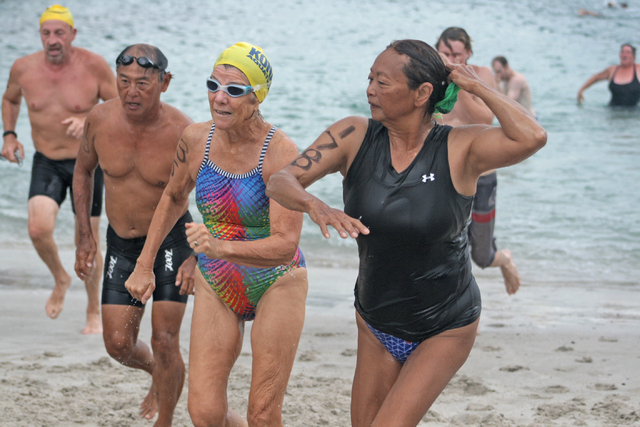Runnin’ with Rani: Swimming for Hawaii’s King

Nestled in the north end of Kailua Bay lies a historic national landmark known as Kamakahonu Beach.
ADVERTISING
Meaning “the turtle eye” in Hawaiian, Kamakahonu was named after a rock in the shape of a turtle that was located to the left of the present beach dating back to 1812, when King Kamehameha The Great returned to the Big Island to live out his remaining years.
Kamakahonu’s most alluring and prominent landmark is the Ahu’ena Heiau, a religious temple that served as the center of political power in the Hawaiian Kingdom during King Kamehameha’s reign.
The Ahu’ena Heiau today is recognized as one of the most historically significant sites in all of Hawaii.
It is the final resting place of King Kamehameha, who passed in 1819. Following his death, his son, Liholiho (Kamehameha II), would go on to end the ancient kapu system – a highly defined regime of taboos that provided the framework of the traditional Hawaiian government, and a year later in 1820, the first Christian missionaries from New England were granted permission to come ashore.
Now nearly two centuries later, Kamakahonu Beach is still revered as a historically sacred site and has also become home to the annual King’s Swim – a 1.2-mile open-water swimming race that will celebrate its 22nd year come the Fourth of July.
“This race honors King Kamehameha,” said race director, Steve Borowski. “He was a water person who did a lot of fishing, diving and water activities all around that area. I always liked the feel of Kamakahonu Bay and where King Kamehameha lived, and so I wanted to maintain that Hawaiiana as it’s such a historic area.”
The Hawaii Waterman Hall of Famer has lived in Kona for the last 30 years and said that when he moved here, he temporarily stopped coaching swimming to be the Director of the Kona YMCA for three years before becoming the IRONMAN race director in 1991.
“During those early years there were no buoys in Kailua Bay so I put in the IRONMAN buoy way before I became IRONMAN director,” Borowski said. “Then I put out the 1.2-mile buoy because I thought that it was a good distance. We triangulated it so that it’s the same distance from when you enter on the pier side to when you exit at Kamakahonu Bay.”
Borowski was so taken by the rich history and old Hawaiiana feel of Kamakahonu Bay that when he became the IRONMAN race director, he did everything he could to have the IRONMAN swim finish there on the white sandy beach.
“Gatorade was the sponsor at that time and thought it was a great idea especially having the (Ahu’ena) Heiau in the back, but they decided to use the boat ramp instead and now they exit from the other side (at Kaiakeakua Beach),” he said. “But we also didn’t have a good 1.2-mile swim race on the island and so I knew that if we were to have one, I’d want it to finish there at Kamakahonu. And the 1.2-mile distance was a realistic goal for most people.”
It was 1995 that Borowski finally turned his dream into reality by organizing the inaugural 1.2-mile open water-swimming event and named it the King’s Swim, in honor of Kamehameha the Great. That year, male and female winning times were awarded to Dietrich Lawrence (25:26) and Gail Grabowsky (25:58) amongst a field of 116 participants.
Borowski added that in the early years, The King’s Swim was held in June, near King Kamehameha’s birthday. But due to other activities such as canoe regattas and parade festivities happening on that weekend in celebration of the King, Borowski ended up moving his event to July and the race has been calendared there ever since.
Yet what hasn’t changed is the $15 entry fee – the lowest of any swim race on the island.
“I committed to that entry fee from the beginning and people often tell me, ‘what are you doing?’” he laughed. “In the early days of course we lost money because we wanted to make sure all the age groups got awards — which is nearly 80 people — and we wanted good giveaways. So now to break even, we ask the community, the Masters and Age-Group swimming families for sponsorships and that’s worked out to help perpetuate this event.”
With the cut-off time designated at one hour and having the race take place over the Independence Day holiday weekend, Borowski expects a competitive field as well as an increase in out-of-town participation.
“We never know who will show but I’m guessing that there will be someone fast that will show up who is here visiting,” he said. “Locally, it looks like Kuulei Patterson and Weylin Foo to be the overall Triple Crown Winners. For the women, Maile Lawson has been swimming well so she may be our top local finisher, while Miki David from Oahu has also signed up. Along with Weylin, my guess would be Silas Wiley and maybe that guy from Hilo (Bodhi Whitmore) to be in the mix for the men.”
Other interesting facts to note are only two people have completed all 21 races – Peaman and Linny Vermiere. Male and female course records are held by Andrew Ezer in 22:47 set in 1996, and Leahi Camacho’s time of 23:20 in 2012.
Nicholas Garrett has the most wins for the men – four consecutive titles between 2007-2010, while Ashley Rose has the most wins for the women – three consecutive crowns between 2000-2002. Brother and sister duo, Ky and Alyssa Foo, both won the event in 2011.
“We never focus on how many as it’s never been about numbers,” Borowski said with a smile. “It’s about having fun and putting on a quality race.”


